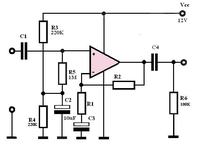jony130
Full Member level 3
Hi, how to determine correct values of feedback resistor in op-amp application :?:
For example if we have to design non-inverting amplifier whit gain 11[V/V] and use uA741 op-amp KU=1+(R2/R1).
Whit of this values you will prefer and why :?:
option 1
R1=100Ω
R2=1KΩ
2
R1=1KΩ
R2=10KΩ
3
R1=100KΩ
R2=1MΩ
For example if we have to design non-inverting amplifier whit gain 11[V/V] and use uA741 op-amp KU=1+(R2/R1).
Whit of this values you will prefer and why :?:
option 1
R1=100Ω
R2=1KΩ
2
R1=1KΩ
R2=10KΩ
3
R1=100KΩ
R2=1MΩ

